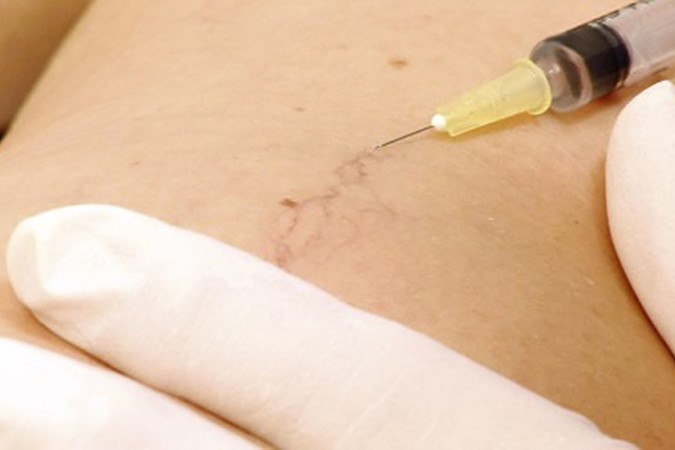Sclerotherapy for the treatment of varicose veins

Sclerotherapy is a medical procedure used to eliminate varicose veins and spider veins. Sclerotherapy involves injecting a solution directly into the vein that causes it to scar and collapse, forcing blood to reroute through healthier veins. The collapsed vein is reabsorbed into local tissue and eventually fades. This is the best method for varicose veins if they are tortuous or recurrent.
What is sclerotherapy?

Sclerotherapy involves an injection of a solution (generally a salt solution) directly into the vein. A strong solution is injected directly into the blood vessel causing inflammation of the walls of the vessel. The vessel disappears over a few weeks to months. Larger varicose veins may also be treated by sclerotherapy. Sclerotherapy effectively treats varicose and spider veins. It's often considered the treatment of choice for small varicose veins.
Benefits of Sclerotherapy
- All treatments are completed in the outpatient clinic
- Each session of treatment lasts about half an hour
- Normal activities can be resumed straight away, but vigorous exercise should be delayed for a week
- Stripping of the vein is avoided and there is little or no discomfort after treatment.
- There is much less bruising than following surgery.
- There is no need for general anaesthetic, incisions in the leg, admission to hospital or an operating theatre.
- Re-treatment for further varices is simple.
- Less expensive than surgical treatment.
- No time needed off work, except for the treatment sessions.
- The treated veins disappear completely after a period of time, and cannot be found even with ultrasound imaging
Candidates for Sclerotherapy
Prior to sclerotherapy, you will have an initial consultation with vascular medicine specialist لینک به مقاله متخصص واریس who will decide if you're a good candidate for the procedure. You are not eligible if you are pregnant. You can have sclerotherapy if you take birth control pills. If you have had a blood clot in the past, your eligibility will be decided on an individual basis, and will depend on the overall health of the area needing treatment as well as the reason for the clot.
How to prepare for procedure
Before the procedure, a specialist will usually review the patient’s medical history and conduct a physical exam. The doctor will examine the veins to be treated and check for any underlying blood vessel disorders. Be sure to let your doctor know:
- If you are pregnant. Most doctors recommend waiting until after your delivery to perform the procedure.
- If you have any medical conditions, such as heart disease or a pre-existing cancer or coagulation disorder.
- About any prescription or over-the-counter medicine you are taking as well as any supplements.
- If you smoke or take oral contraceptives, which can increase your risk of blood clots.
- If you have any allergies.
Sclerotherapy procedure

First a Duplex ultrasound scan should be performed to map out the path of superficial, perforator and deep veins. Those greater than 5mm in width and demonstrating reflux are the most suitable for treatment. Sclerotherapy of larger superficial veins and perforator vessels is usually performed with ultrasound (echo) guidance.
In most cases of sclerotherapy, the salt solution is injected through a very fine needle directly into the vein. At this point, you may experience mild discomfort and cramping for one to two minutes, especially when larger veins are injected causing them to permanently seal. The vein is then turned into scar tissue that is eventually removed by the body. The procedure itself takes approximately 15 to 30 minutes. The number of veins injected in one session depends on the size and location of the veins, as well as the general medical condition of the patient. Sclerotherapy is performed in the doctor's office by a specialist or a surgeon and requires that you do not do any aerobic activity for a few days after the procedure. This treatment requires no healing or downtime, but a daily walking regimen may be suggested as the body works to remove the veins.
Foam Sclerotherapy

Treatment is usually performed in a treatment room or ultrasound examination room. The patient rests comfortably on a bed. Very little discomfort results from the injections so no sedation or anaesthetic is required. In order to treat large varicose veins it is necessary to block the main vein feeding the varices. This could be done surgically, but with foam treatment all that is necessary is to put a needle into the main affected surface vein. This is the only part of the procedure which might cause discomfort and is usually performed with a small amount of local anaesthetic. The position of the needle is carefully monitored using ultrasound imaging so that it is in exactly the right place. Next, the foam is injected whilst watching its progress using the ultrasound machine. Surprisingly, injecting the foam causes no discomfort, although the leg may ache slightly afterwards. The varicose veins in the leg are checked to see if foam has entered these from the main surface vein where the injection was given. A few further injections are usually given through a tiny needle in order to make sure that all the varicose veins have been completely injected. The whole treatment usually takes no more than 20 – 30 minutes. Finally a firm bandage is applied to the leg. The aim of this is to keep the veins compressed so that they do no fill with blood when the patient stands up. The bandage is usually worn for a week or two followed by an elastic compression stocking for a further week.
What to expect after the procedure?
- You can stand up and walk around immediately after the procedure. It's important to move your legs to prevent the formation of blood clots and maximize treatment results.
- Compression stockings and/or bandages are worn over the treatment area for one to three weeks to maintain pressure on the treated veins.
- Most people can return to normal activities immediately following the procedure.
- You should avoid sun exposure in the treatment area for two weeks following the procedure.
Risks and side effects
- The treatment produces mild discomfort in the leg which may last for 2 – 4 weeks.
- It also produces mild bruising and some lumps which may last for several weeks following treatment. However, both of these features are usually seen following surgical treatment for varicose veins.
- The final outcome may take a number months to evolve following treatment, and this is longer than would be taken following surgery.
Cost
The average cost for sclerotherapy varies by the size and number of veins treated, doctor's fess and geographical location.





